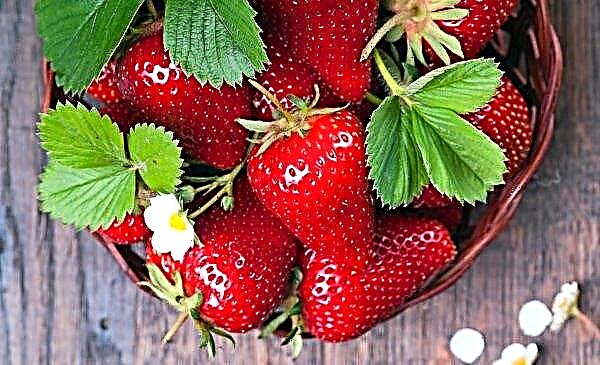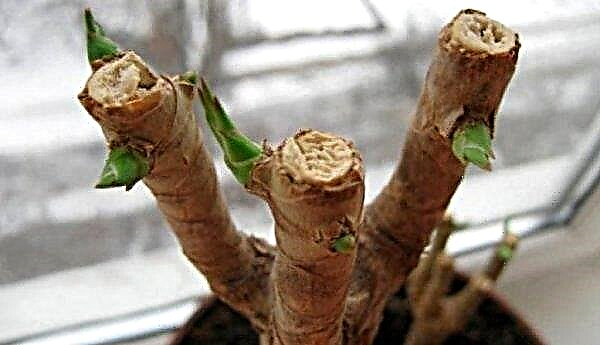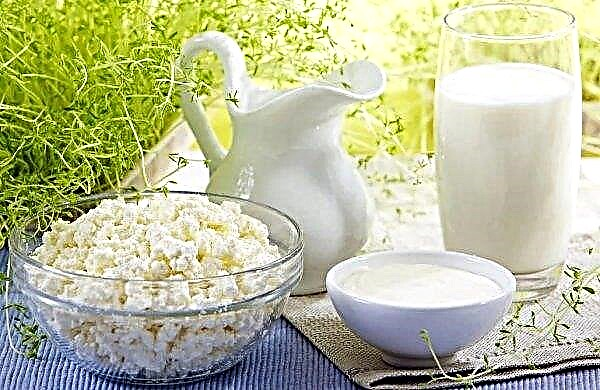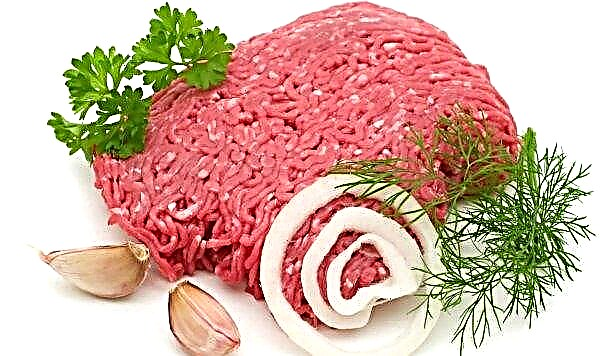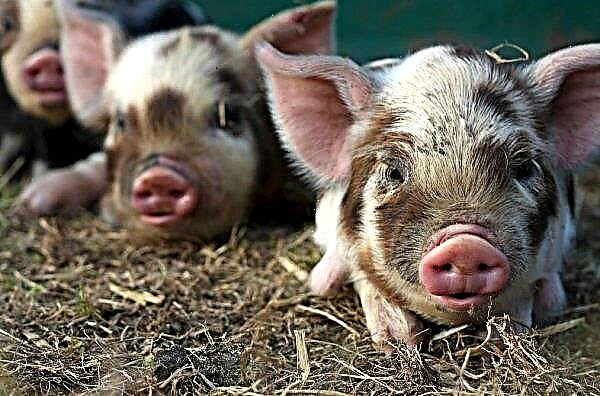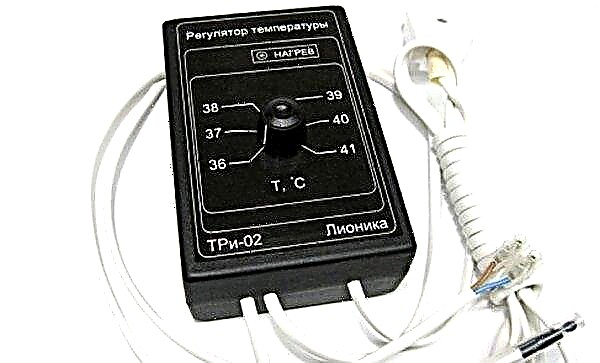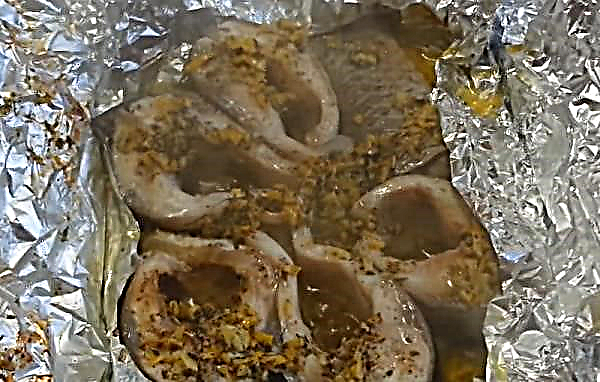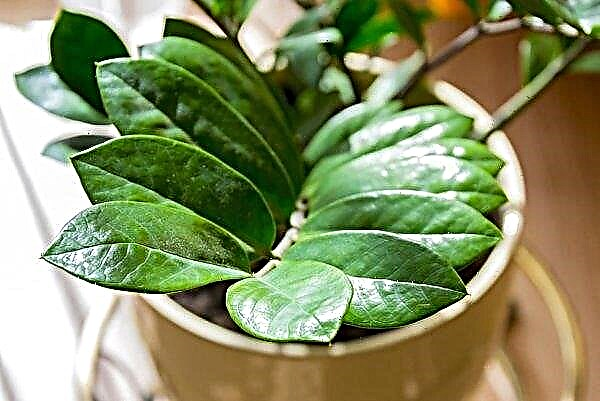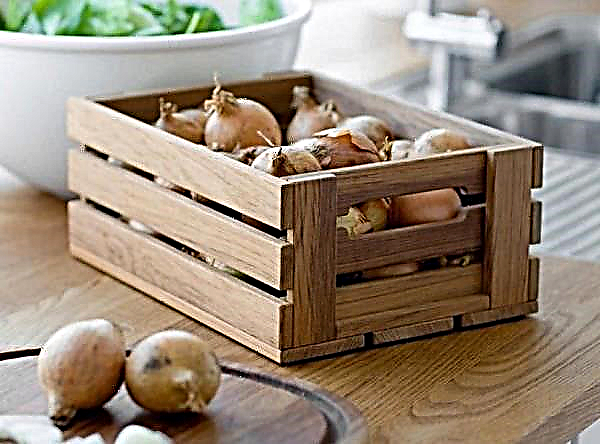The tomato variety Chio Chio San from the employees of the Russian company Gavrish won the hearts of domestic gardeners. If you are not already familiar with it, we suggest that you learn about its main characteristics and features of cultivation.
Description of the variety "Cio Cio San"
The first-generation hybrid, Chio Cio San, was bred by Russian breeders in 1998. It was officially registered a year later.
Characteristic of Chio Chio San Tomatoes:
- ripen in the middle term - the first fruits are formed 110–120 days after emergence;
- bushes are tall, indeterminate, 150–200 cm high;
- powerful bush crown;
- small leaves, dark green in color, very pubescent;
- the first ovary is formed after 8-9 sheets, in the future - after every 3rd;
- the tomato bears oblong shape;
- thin peel of tomatoes;
Did you know? A botanist from Sweden, Karl Linney, who gave Latin names to a huge number of plants, called the tomato Solanum lycopersicum, which means wolf peach.
- the color of the fruit is pink;
- the average weight of the fruit is 30-50 g;
- variety productivity - 5-6 kg from a bush;
- 50 fruits are formed on one brush;
- pulp fleshy, moderately dense, dessert taste;
- in fruits 2 chambers and few seeds;
- the hybrid is resistant to major fungal diseases;
- the fruits have a universal purpose - they are used fresh, for winter harvesting, making juice, sauces;
- perfectly maintain appearance after transportation;
- distinguished by good keeping quality;
- suitable for cultivation in areas with a climate unfavorable for agriculture;
- can be cultivated in open ground, in a greenhouse, in a greenhouse, under a film.

Advantages and disadvantages
- The variety "Cio Cio San" is appreciated due to such advantages:
- resistance to most diseases, including late blight and mosaic;
- high productivity;
- synchronous ripening of the crop;
- universality of use;
- commercial cultivation opportunities;
- excellent taste and technical qualities of the fruit.
- Those who have already planted "Cio Cio San" note the following disadvantages of the variety:
- tendency to crack fruits during prolonged stays on the bush;
- the seeds do not retain varietal qualities; for reproduction, each time it is necessary to acquire new seeds;
- the need for constant care.
Features of growing varieties
For successful fruiting, you will need to grow tomatoes with seedlings. The seedless method is only suitable for cultivating this garden plant in regions with a warm climate and mild winters.
With the seedling method, first for 1.5–2 months, sprouts are grown from seeds from indoor seeds, which are then transplanted to a permanent place - in the garden bed or in the greenhouse.

Microclimate
Tomatoes give the highest yields, subject to growth in such conditions:
- in a sunny, calm place;
- at air temperature - +20 ... + 25 ° С;
- with air humidity - 60–70%;
- in good light.
Important! With an increase in temperature indicators above +30 ° C, as well as a decrease to +10 ° C, tomatoes slow down or stop growth and development. Reducing temperature can be achieved by watering and spraying, increasing - shelter of beds.
Seed sowing technology
Chio Cio San seeds are purchased at the store. They do not require additional processing, since the manufacturer has already taken care of the seed dressing.
Sowing is carried out in the last week of March.
For the germination of seedlings, special containers will be required - this can be:
- one long box made of wood or plastic;
- 200 gram plastic cups;
- glasses of peat;
- cassette.
It is believed that stronger seedlings can be grown in separate containers.

Also, for the germination of seedlings, soil is needed. In the store you can buy peat substrate. It is possible to make it with your own hands.
To do this, mix:
- peat - 2 parts;
- turf land - 1 part;
- humus (compost) - 1 part;
- sand - 0.5 parts.
- Disinfect by watering with a weak (pink) potassium permanganate solution, Fitosporin preparation or calcining in an oven (microwave) at a temperature of +70 ... + 90 ° С.
- Moisturize well.
- To sustain in room conditions throughout the day.
Did you know? From a botanical point of view, tomato fruits are multi-nested paracarp berries.
After preliminary preparation, you can sow the seeds:
- Make grooves in the substrate with a depth of 1-1.5 cm.
- Place tweezers in them for 1-2 seeds at a distance of 1 cm.
- Fill the soil with a 0.5-centimeter layer.
- To water.
- Cover with foil or glass.
- air temperature - +22 ... + 25 ° С;
- air humidity - 60–70%;
- good lighting - 14-16 hours (if necessary, organize artificial lighting).

Seedling Care
Seedling care consists of the following procedures:
- regular watering of the substrate;
- daily airing;
- fertilizer application;
- pick;
- hardening (for landing on an open bed).
After the first shoots have appeared - about 3-4 days after sowing - the shelter should be removed.
When 1-2 real leaves are formed, the sprouts need to be dived - planted in different peat pots or tablets with a nutritious substrate, Signor Tomato fertilizer (3 tbsp. For 5 l of soil) or a full mineral supplement (1 tbsp. 5 l of soil).
As before, they are regularly moistened and sprayed. Recommended air temperature during the day - not lower than +18 ° С, at night - not lower than +12 ° С.
During the development of sprouts, 2 weeks after the pick, they can be fertilized with mineral additives - Kemira Plus, Agricola, or other complex fertilizers intended for seedlings.If you plan to cultivate in open beds, then 7-10 days before the planned date of transplantation into the soil, it is recommended to begin hardening of seedlings - on warm days, take out pots in fresh air, starting from 5 minutes a day. Every day, the duration of the hardening procedure will need to be increased.
A few days before the plan to move the sprouts into the ground, stop their watering.
Planting seedlings in the ground
The time for replanting the sprouts in the garden depends on the climatic zone where they are cultivated. It may be the end of May - the beginning of June. Seedlings are transferred to the greenhouse in the middle - end of May. At this time, the sprouts should reach the age of 55-60 days.
About a month before planting, the soil is disinfected and fertilized - humus or compost with wood ash is mixed. Immediately before planting in the soil, they make holes slightly larger than an earthen lump. Peat pots or tablets with sprouts are simply placed in them and sprinkled with earth. Plastic glasses are cut with scissors, the sprouts are removed along with an earthen lump and moved to the landing hole.

The recommended planting scheme is 70 × 70 cm. The sprouts are placed in a hole at an angle of 45 °, making sure that neither the leaves nor the trunk come into contact with the ground. Planting is abundantly watered.
Then set the trellis, as tying is a mandatory procedure for tomatoes "Cio Cio San". Upon reaching a height of 0.5 m, they will need to be tied to a trellis or pegs.
If tomatoes are planted in the open ground early, or if there is a possibility of frost, the plantings are covered with a film or non-woven material.
Important! In accordance with the rules of crop rotation, tomatoes must be planted after cauliflower and cabbage, pumpkin and bean crops, root crops and onions. Bad predecessors are potatoes, peppers, and eggplant.
Care Features
Care for tomatoes "Cio Cio San" consists in the following procedures:
- watering;
- top dressing;
- stepchildren;
- garter;
- loosening the soil;
- weeding;
- hilling.
Fertilizer and watering
For fertilizing tomatoes, use a variety of fertilizers:
- mineral (ammonium nitrate, ammonium sulfate, ammonium sulfate, urea, superphosphate, potassium salt);
- organic (mullein, compost, bird droppings);
- complex ("Kemira universal-2", "Kemira luxury", "Solution", "Universal", "Potassium monophosphate");
- yeast and herbal dressings.

It will take 3-4 dressings per season:
| Term | Fertilizer |
| After 14–20 days after the seedlings have moved into the ground | 40 g of phosphorus-containing fertilizers + 15 g of potash + 25 g of nitrogen + 10 l of water. The flow rate of the working fluid is 1 l / 1 bush |
| During the appearance of flowers | 0.5 l mullein or bird droppings + 1 tbsp. potassium sulfate + 10 l of water or nitrophosphate, "Solution", "Kemira-universal" |
| During the formation of the ovary | Infusion of wood ash (2 l / 10 l of hot water) + 10 g of boric acid |
| In the phase of mass fruiting | 2 tbsp. superphosphate + 1 tbsp. sodium humate + 10 l of water |
Root top dressing is recommended to alternate with foliar. The best foliar bait for tomatoes is yeast.
It is prepared by mixing:
- 10 g dry yeast;
- 0.5 l of wood ash;
- 5 tbsp. Sahara;
- 10 liters of water.
Tomato bushes are processed at the stage of budding and blooming of the first flowers.
For the first time after planting, tomato bushes are watered in 10-12 days. Use warm, settled or rain water with a temperature of at least +20 ° С.
Before the start of the production of flowers, about 1 liter of water will need to be consumed per 1 m². In the phase of blooming flowers and the formation of ovaries - up to 12 liters.

The optimal regime for watering tomatoes is 1-2 times in 7 days. The best time to moisturize is the evening after the sun hides, or a cloudy day. When watering, it is necessary to ensure that moisture does not fall on the foliage and stems. This will prevent the development of burns in plants.
Tomatoes can be watered manually - using a hose (under the root, excluding moisture from the organs of the bush) and a drip subsoil method. More preferred, convenient, efficient and economical is drip irrigation.
Since tomatoes do not tolerate both drought and waterlogging, it is necessary to ensure that they are watered in moderation. In order to find out whether the plants are watered well, gardeners use the following method: they compress a lump of soil isolated from a depth of 10 cm in a fist. If it is well molded into a mold and disintegrates, then watering is sufficient.Important! Fertilizing under the root is carried out only after heavy watering.
Shrub formation and pinching
It is a must to plant Chio Cio San tomatoes. Without this procedure, the level of productivity will significantly decrease, without garter, the stems will lie on the ground, break.
In a tomato bush, as it grows, many side shoots or stepsons are formed. Their large number leads to:
- thickening of landings;
- the development of ailments caused by fungi;
- the formation of small fruits or their late ripening.
In order to avoid these problems, stepsoning is carried out, i.e., removal of lateral shoots growing in the axils of the leaves. They are either cut off with their hands or cut off with scissors, leaving "stumps" of 5 cm each. As a result, only one main stem should remain. 2 stems are also allowed.

The sooner additional stepchildren are removed, the better the crop will be able to get. It is necessary to conduct stepsoning 1-2 times a week. In addition to the clipping of the side shoots, they also remove the lower leaves that are in contact with the ground. This will avoid the development of diseases.
Soil cultivation and weeding
Loosening of the soil must be done after each irrigation and rainfall. It is required in order to give air to the roots, as the wet soil becomes dense.
Loosen the soil in the near-stem zone carefully so as not to touch and damage the rhizome. Tillage combine with hills and weeding.

For the first time, the soil is loosened to a depth of 8–12 cm. Subsequently, more surface loosening is used - to a depth of 4–5 cm.
During the season it is necessary to produce at least 3-4 cultivations.
Hilling is optional. Each gardener decides for himself whether to produce it or not. If a decision is made about the need for hilling, then it is carried out with a hoe or trident rake. They pour a hill of soil to the stem.
Hilling:
- enriches the soil with oxygen;
- strengthens the rhizome;
- contributes to the formation of additional roots.
Optionally, but preferably mulch the soil. The mulching procedure allows you to limit the growth of weeds and save moisture in the soil.

For mulching use:
- mowed grass;
- peat;
- the straw.
Diseases and Pests
Tomatoes "Cio Cio San" are resistant to the main diseases characteristic of these plants, therefore, prevention, for example, against such serious diseases as late blight and mosaic, is not necessary.
Pests also rarely bother the plant, however, provided that it is grown under the right conditions and necessary care is taken. Special preventive treatments do not need to be done. In order to prevent the invasion of pests, one should adhere to crop rotation rules and apply mixed plantings.
Planted nearby insects can scare away harmful insects from tomato bushes:
- calendula;
- marigold;
- lupine;
- mustard;
- oil radish.
Harvesting and storage
If you plan to transport and store tomatoes for a long time, then you need to remove them in a state of technical maturity - brown. After collection, they are laid out in wooden or plastic boxes, where they ripen.
Since tomatoes of this variety are prone to cracking during prolonged stays on the bush, inspection and cleaning of the beds must be done daily. It’s better to do this in the early time. Ripe and spoiled fruits are removed. It is important to clean ripened berries in a timely manner, since this way the bush can accumulate more nutrients for the formation and maturation of the following tomatoes. In this way, higher yields can be achieved.

Short-term storage of tomatoes must be done at a temperature of +18 ... + 25 ° С and humidity 80–85%.
For long-term storage, the most dense, intact tomatoes are selected. They are stored at a temperature of +11 ... + 13 ° С and humidity of 85–90%.
So, the tomato variety “Cio Cio San” has been delighting gardeners with plentiful fruiting and delicious fruits for decades. It is not difficult to grow it - the main thing is to adhere to the basic recommendations for planting and care.Did you know? Botany belongs to the solanaceous tomato family, which means that it is a relative of potatoes and tobacco.
Network user reviews
ADVANTAGES: Luxurious brushes, numerous quality fruits. You can drive tours to the bushes of this variety.
DISADVANTAGES: Tomatoes are absolutely not suitable for pickling, it is better to pickle them.
I grew Chio Cio San tomatoes for the first time last year. Honestly, I planted them just for fun, very beautiful photos of this variety walk on Internet forums. Besides, at the same time I decided to try the new for me seed producer NK Elit. I did not expect anything special from inexpensive seeds, nevertheless, this particular tomato variety grew most of all last summer.
The variety coincided absolutely completely, the tomatoes were exactly the same as in the photo of the seed packaging and all the characteristics of the variety coincided 100%.The seeds sprouted wonderful and friendly, for which NK Elit is a solid five and my trust, now I will definitely buy their seeds.
"Cio Cio San" - a tomato variety is really unusual and very impressive. I have grown exactly the same huge spherical heavy brushes with an incredible amount of beautiful, high-quality, pink tomatoes on them, as in numerous photographs on the Internet. I didn’t even count on that.
The fact is that I planned to plant only a couple of bushes of tomato "Cio Cio San" for testing, but the spring turned out to be unsuccessful and I lost a lot of seedlings of other varieties, and then in the summer the remaining varieties began to hurt. And since the seeds of "Cio Cio San" sprouted very well and the seedlings of this variety resisted, I replaced the lost varieties with this variety.
When the tomatoes began to bloom, knit and ripen, I realized that there would still be a crop. The fruits of the tomato "Cio Cio San" are one-dimensional, plump, drop-shaped, without damage and cracks, quite good taste. Sometimes the "Cio Cio San" is referred to as cherry tomatoes, but this is not right, they are larger than any cherry. Just suitable, like me at first it seemed for salting. I fermented them almost everything, but now I’m not happy. We tried the Chio Cio San tomatoes in fermented form, but they did not ferment, as expected, I already thought that I somehow salted them incorrectly. Here recently opened a can of fermented assorted tomatoes. There were tomatoes of the Cio Cio San variety and tomatoes of the Pertsovka variety. My review of the Pertsovka tomato. So, in the same pickle, “Cio Cio San” was not salted, but “Pepper” was delicious.
From here I conclude that the tomatoes "Chio Cio San" are absolutely not suitable for sourdough. But my mother made them pickled and very successful.
I warned, and you draw your conclusions.

